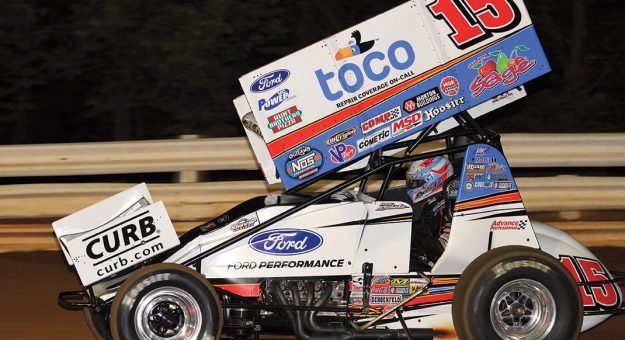On Friday night, Oct. 18, Donny Schatz drove a Ford-powered sprint car to victory lane at the World of Outlaws event at Lakeside Speedway in Kansas.
On Friday night, Oct. 18, Donny Schatz drove a Ford-powered sprint car to victory lane at the World of Outlaws event at Lakeside Speedway in Kansas, marking the first victory for Ford in Outlaws competition in more than 21 years.
The blue oval is back in sprint car racing, in a big way. The win for Schatz and his Tony Stewart Racing team brought early success to a development program that began just two years ago.
Stewart, who has been associated with Chevrolet and Mopar at different points through the years, began an alliance with Ford in NASCAR Cup competition in 2017.
Somewhere along the line, Stewart and the folks at Ford Performance became intrigued with the idea of bringing Ford back to sprint car racing.
But the idea was daunting, given the fact that engines have become very specialized — and highly evolved — in sprint car racing. Hundreds of contemporary engines — based on the famed Chevrolet small block that debuted in the 1950s — are assembled each year, with a vast number of bolt-on parts and accessories readily available.
The most challenging aspect of the Ford launch was this: for more than a decade, virtually no supporting pieces and parts have been developed for a Ford sprint car engine.
The project began in 2017 with a Ford engine block, and from that point an array of people went to work developing the pieces and parts needed to make it go.
Stewart and Ford turned to a number of well-known sprint car people, as well as engine people with success in other forms of motorsports.
The fact that Schatz wheeled to victory lane with an engine that has fewer than 25 nights of on-track research and testing was not only an enormous accomplishment, but a validation of the work of some highly-successful racing minds.
In a sense, modern sprint car engines are something of a dinosaur.
In terms of technology, they are decades behind what is used in automobiles today. With mechanical fuel injection and relatively primitive ignition technology, sprint cars long ago lost any connection to the engines found on the highway.
Combining digitally-metered electronic fuel injection and logic-based ignition, the typical mass-produced automotive engine today is vastly superior in terms of efficiency, emissions, and durability. The technology found under the hood of the cheapest Kia on the lot is an engineering marvel compared to a World of Outlaws sprint car.
A contemporary sprint car engine, however, does one thing extremely well: it produces a prodigious amount of horsepower, particularly when considered on a weight-to-horsepower ratio. And prodigious horsepower is the heart and soul of sprint car racing.
 More important is the evolution that has taken place over the past 25 years in sprint car engines. Beginning in the 1990s, a concerted and collective effort was made to lighten every component on the race car, particularly rotating weight.
More important is the evolution that has taken place over the past 25 years in sprint car engines. Beginning in the 1990s, a concerted and collective effort was made to lighten every component on the race car, particularly rotating weight.
In due course, dozens and dozens of people discovered ways to shave a couple of ounces here, a couple of ounces there, and eventually reached a point that — just a few years ago — would have been looked upon as impossible.
Other forms of racing — stock car racing, drag racing, off-road, whatever — did not shave weight nearly as effectively as in sprint cars. Engine builders throughout motorsports often laugh when asked about sprint car engines, and you sometimes hear the word “crazy” to describe what has happened.
The amazing weight savings start right at the beginning. A new Donovan engine block for Outlaws competition weighs just around 85 pounds (less with titanium caps); a contemporary set of cylinder heads weighs about 23 pounds on each side.
When you share these numbers with people outside sprint car racing, they often react with disbelief. How can it be possible to make that much horsepower yet be that light?
The most immediate challenge facing Ford — or any manufacturer interested in bringing their engine to sprint car racing — is catching up with contemporary engines in terms of weight.
They‘ve got to get way, way light; and they‘ve got to get there fast.
To continue reading, advance to the next page.
